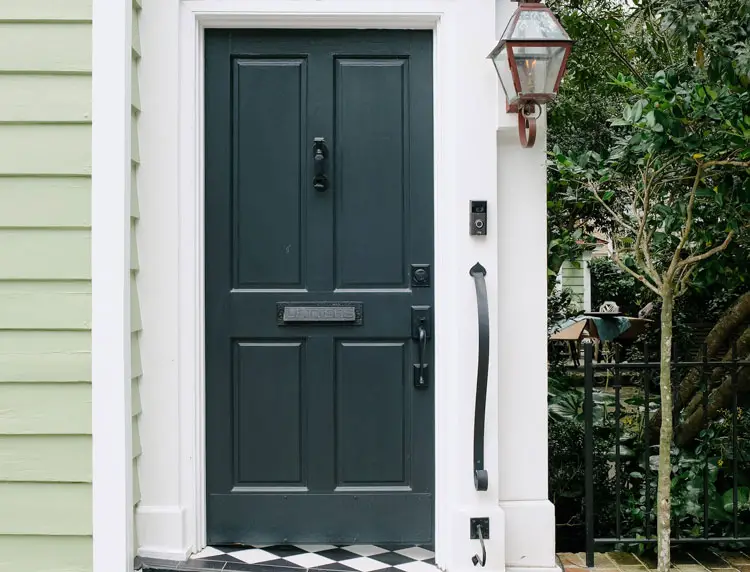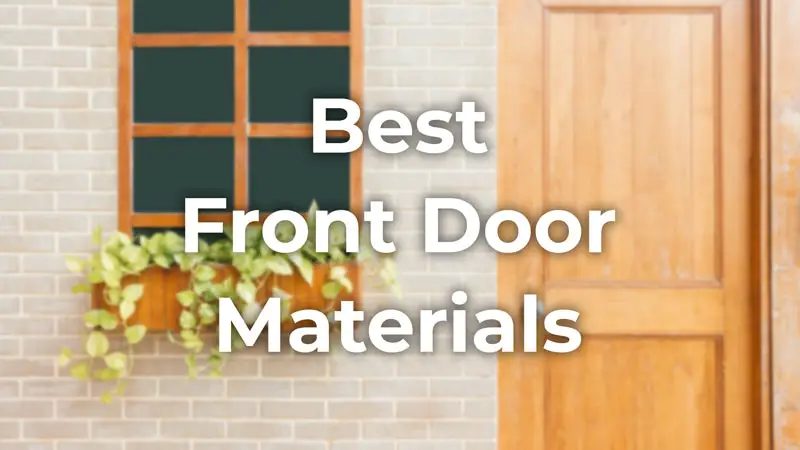When selecting a front door, the choice of materials plays a crucial role in overall performance and longevity.
With a variety of options available, such as wooden, steel, fiberglass, and glass doors, it’s essential to understand the pros and cons of each to make an informed decision.
In this article, we’ll explore the top front door materials and guide you toward choosing the perfect entryway for your home.
Before we get started, here’s a brief summary of the best entry door materials:
- Steel doors are a great choice if you need excellent strength and security but they’re vulnerable to scratches.
- Fiberglass doors are lightweight, low-maintenance, durable, and energy-efficient, and they also have a long service life but they are not budget-friendly.
- Wood doors provide a classic look but require more upkeep.
Why Is It Important to Choose Your Front Door Material Wisely?
The choice of front door materials can significantly impact various aspects of your home. From enhancing curb appeal to providing insulation and security, the right material ensures a harmonious blend of aesthetics and functionality.
Let’s explore the key factors to consider when choosing the best front door material.
Wooden Front Doors
Wooden doors have long been popular for front entryways, exuding a timeless charm and elegance. They offer natural warmth and richness that can enhance the overall aesthetics of your home.

However, there are both advantages and disadvantages to consider.
Advantages
- Wood doors provide excellent insulation, helping to regulate indoor temperature and reduce energy costs.
- They are also customizable, allowing you to choose from various designs, finishes, and stains to match your home’s architectural style.
- Wooden doors have a certain visual appeal that can create a warm and inviting entrance.
- They can be manufactured off-site and installed rapidly with fewer complications when compared to conventional doors (1).
- Moreover, they offer environmental advantages by utilizing renewable resources (2).
Disadvantages
- Wooden doors require regular maintenance to prevent warping, rotting, or fading due to weather conditions.
- They are more susceptible to damage from moisture and pests, demanding periodic refinishing and sealing.
- Wood doors tend to be more expensive (usually up to $3000) compared to other materials, making them a significant investment.
- Wooden doors are flammable, igniting at temperatures ranging from 200-400°C. However, the fire risk associated with wood can be diminished by applying fire retardant coatings.
- They can be susceptible to termite damage.
Fiberglass Doors
Fiberglass doors have gained popularity in recent years due to their durability, versatility, and low maintenance requirements.

They offer several benefits that make them a compelling option for homeowners seeking a balance between aesthetics and practicality.
Advantages
- Fiberglass doors are highly resistant to extreme weather conditions, such as heat, cold, and humidity, making them ideal for various climates.
- They are also energy-efficient, providing good heat insulation and reducing energy costs (3).
- Fiberglass doors offer excellent durability, as they are resistant to dents, scratches, and warping.
- They require minimal maintenance and can withstand the test of time without losing their aesthetic appeal.
- Fiberglass doors are lightweight which facilitates effortless installation and handling.
Disadvantages
- One potential drawback of fiberglass doors is their higher upfront cost compared to some other materials (higher quality doors can cost $2000 or more (4)). However, on average they’re less expensive than wooden doors. Considering their long service life and low maintenance requirements, the initial investment often pays off in the long run.
- Fiberglass doors may lack the same level of strength as steel doors.
- Additionally, while fiberglass doors can mimic the appearance of wood, some homeowners may prefer the authenticity and natural beauty of real wood.
Steel Front Doors
Steel doors are renowned for their strength, security, and affordability. They provide a robust barrier against intruders and offer a range of benefits that make them a popular choice for entry doors.

Advantages
- Steel doors are incredibly durable, resistant to harsh weather conditions, and can withstand impacts, making them highly secure.
- They require minimal maintenance and are less susceptible to warping, rotting, or cracking compared to wood doors.
- A steel door offers excellent insulation, contributing to energy efficiency and reducing heating and cooling costs.
Disadvantages
- One notable disadvantage of steel doors is their vulnerability to dents and scratches, which may require touch-ups or repainting over time.
- Also, they can conduct heat and cold, which may impact their insulation properties in extreme weather conditions. However, a modern steel door often features insulation cores that mitigate this issue.
- When not properly maintained, they can be prone to rust and corrosion.
If you want to improve your front door security, here are my best tips.
Other Popular Front Door Materials
While wooden, fiberglass, and steel doors are among the most common exterior door materials, there are other options worth exploring:
Aluminum Front Doors
- Lightweight and corrosion-resistant, aluminum doors offer durability and versatility.
- They require minimal maintenance, as aluminum does not need painting.
- Aluminum doors are commonly used for contemporary and modern-style homes.
- Keep in mind that aluminum is a metal that conducts heat and cold, potentially leading to thermal transfer.
- It’s not a cheap choice.
Glass Front Doors
- Glass doors can create an elegant and sophisticated entrance.
- They allow natural light to filter into your home.
- A glass front door offers clear visibility, allowing you to see outside and enjoy scenic views.
- They require more maintenance to keep them clean and free from fingerprints.
- A door with a transparent glass panel may compromise privacy.
- Make sure you opt for double-glazed panels to reduce heat and cold transfer.
- Glass doors may be more susceptible to break-ins so make sure you use additional security protection, such as applying security film.
Composite Front Doors
- Composite doors combine different materials, such as wood, fiberglass, and PVC, to offer enhanced durability, insulation, and security.
- They require minimal upkeep.
- They come in a variety of designs, finishes, and colors.
- Composite entry doors are not cheap.
- Also, composite doors can be heavier than other options, requiring sturdy installation and potentially making handling more challenging.
- In the event of damage, repairing a composite front door may be more difficult compared to materials like wood.
Comparing Front Door Materials
To help you make an informed decision, let’s compare the three primary exterior door materials based on various factors:
Maintenance and Durability
Wooden doors require more maintenance, including regular painting or staining, sealing, and repairs. Fiberglass front doors are low maintenance, while steel doors may require occasional repainting to address scratches or signs of wear.
Cost and Budget
Wooden doors tend to be more expensive, with fiberglass doors falling in the middle range and steel doors offering a cost-effective option.
Aesthetics and Design
Wooden entry doors offer a classic and traditional look, while fiberglass front doors can mimic the appearance of wood without maintenance requirements. Steel doors often have a modern and sleek aesthetic.
Security and Energy Efficiency
Steel doors provide the highest level of security due to their strength, followed by fiberglass doors. A wood door can be secure but may require additional reinforcements. In terms of energy efficiency, fiberglass, and steel doors generally outperform wooden doors.
Factors to Consider
When choosing the best front door material for your home, consider the following factors:
- Climate and Weather Conditions: Select a material that can withstand the local climate and weather extremes.
- Home Style: Ensure the exterior door material aligns with the architectural style and character of your home.
- Personal Preference: Consider your preferences regarding aesthetics, maintenance, and overall design.
- Security Requirements: Evaluate the level of security needed and choose a material that meets your security expectations.
- Budget: Determine your budget and explore options within your price range.
Tip
Consider the architectural style of your home when choosing a front door material. For a traditional or rustic look, opt for a wooden door, while a modern or contemporary style can be complemented by a sleek fiberglass or steel door.
Making the Right Choice
To make the best decision, weigh the advantages, disadvantages, and factors mentioned above.
Remember, choosing the right front door material is an investment in your home’s security, aesthetics, and energy efficiency. Take the time to explore different options, consider your needs and preferences, and consult with professionals to make an informed decision. You can also visit a showroom to see and feel the different materials firsthand.
By selecting the perfect front door material, you can create an inviting and secure entryway that sets the tone for your home.
Conclusion
Choosing the best front door material is a crucial decision that impacts the security, aesthetics, and energy efficiency of your home.
A wooden door exudes charm but requires more maintenance. A fiberglass door offers low maintenance and durability, while a steel door provides unmatched security. Consider your climate, budget, and personal preferences to make the right choice for your home.
Remember, investing in a high-quality front door made from the best material will not only enhance your home’s curb appeal but also provide peace of mind and long-term value.
Frequently Asked Questions
What is the best front door material for direct sunlight?
Fiberglass is generally recommended as the best front door material for direct sunlight due to its ability to withstand prolonged exposure to sunlight without significant damage.u003cbru003eu003cbru003eIt has excellent resistance to warping, cracking, and fading. Additionally, fiberglass doors often come with UV-resistant coatings that further protect against sun damage. Choose a door with a lighter color finish, as darker colors may absorb more heat from the sun.
Are wooden doors a good choice for areas with extreme weather conditions?
While wooden doors can be used in various climates, they require more maintenance and may not be as resistant to extreme weather as fiberglass or steel doors.
Are steel doors prone to rusting?
Modern steel doors are typically treated to resist rust and corrosion. Proper maintenance, including regular repainting, can help prolong their lifespan.
Can fiberglass doors mimic the look of real wood?
Yes, fiberglass doors can replicate the appearance of wood with realistic grain patterns and finishes, providing a low-maintenance alternative to wooden doors.
Do front door materials impact energy efficiency?
Yes, front door materials play a role in energy efficiency. Fiberglass and steel doors generally offer better insulation properties compared to wooden doors.
How often should front doors be replaced?
The lifespan of front doors varies depending on the material and maintenance. However, well-maintained doors can last for decades before needing replacement.
Photos: Flickr(ntm1909)











